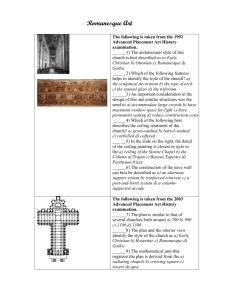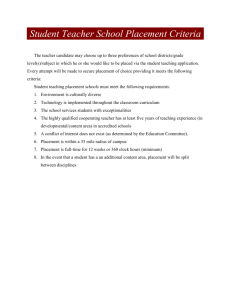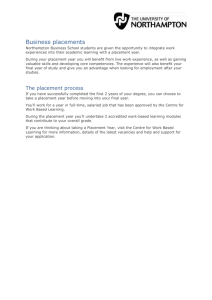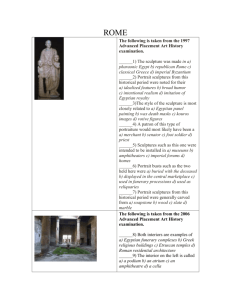Art History Test on Gothic Art
advertisement
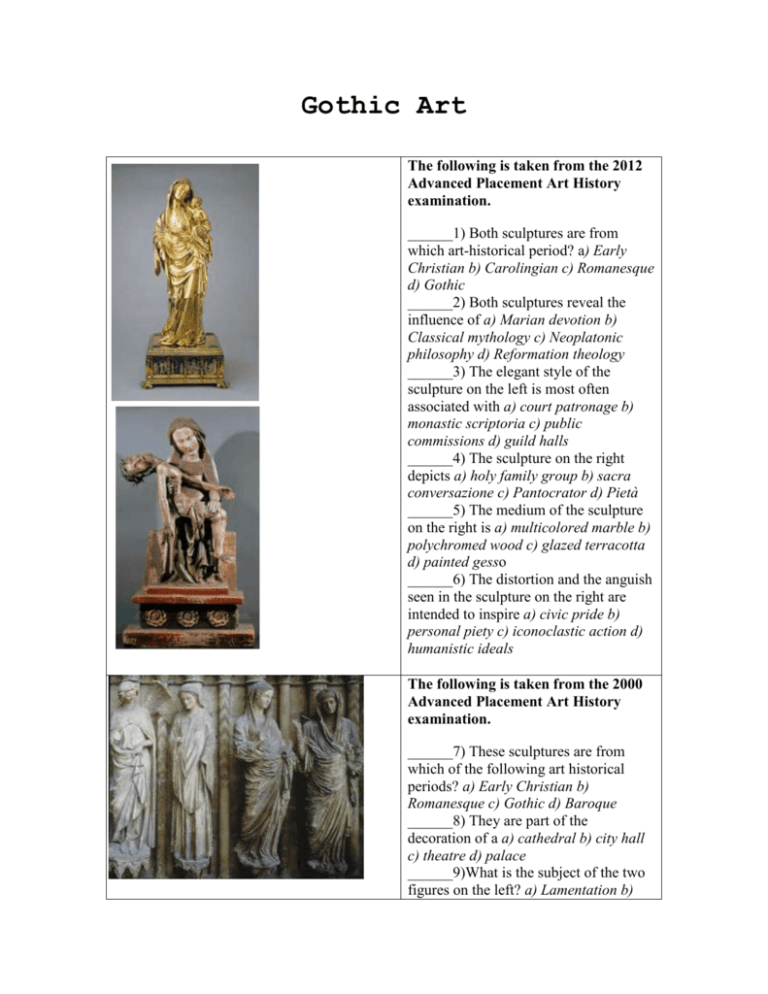
Gothic Art The following is taken from the 2012 Advanced Placement Art History examination. ______1) Both sculptures are from which art-historical period? a) Early Christian b) Carolingian c) Romanesque d) Gothic ______2) Both sculptures reveal the influence of a) Marian devotion b) Classical mythology c) Neoplatonic philosophy d) Reformation theology ______3) The elegant style of the sculpture on the left is most often associated with a) court patronage b) monastic scriptoria c) public commissions d) guild halls ______4) The sculpture on the right depicts a) holy family group b) sacra conversazione c) Pantocrator d) Pietà ______5) The medium of the sculpture on the right is a) multicolored marble b) polychromed wood c) glazed terracotta d) painted gesso ______6) The distortion and the anguish seen in the sculpture on the right are intended to inspire a) civic pride b) personal piety c) iconoclastic action d) humanistic ideals The following is taken from the 2000 Advanced Placement Art History examination. ______7) These sculptures are from which of the following art historical periods? a) Early Christian b) Romanesque c) Gothic d) Baroque ______8) They are part of the decoration of a a) cathedral b) city hall c) theatre d) palace ______9)What is the subject of the two figures on the left? a) Lamentation b) flight into Egypt c) Annunciation d) Adoration ______10) The two figures on the right reflect the influence of which of the following earlier styles? a) Archaic Greek b) Islamic c) Roman d) Byzantine ______11) The two figures on the left reflect the impact of a) the French court style b) vase painting c) Renaissance naturalism d) Mannerism ______12) The differences in style between the two pairs of figures confirm the fact that a) the works were carved in different centuries b) several workshops were involved c) different materials were used d) works were imported from other countries ______13) Which of the following is an innovative feature of these four figures? a) they are part of a decorative program b) they represent biblical characters c) they portray French royalty d) they are nearly freestanding The following is taken from the 2007 Advanced Placement Art History examination. Identify the medium and art-historical period of the object shown. Explain the religious and visual reasons for the extensive use of this medium during its period. The following is taken from the 2002 Advanced Placement Art History examination. The following passage was written by Abbot Suger (1081-1144). Moreover it was cunningly provided that… the old [church] should be equalized, by means of geometrical and arithmetical instruments, with the central nave of the new addition; and, likewise, that the dimensions of the old side aisles should be equalized with the dimensions of the new side aisles, except for that eloquent and praiseworthy extension, [in the form of] a circular string of chapels, by virtue of which the whole [church] would shine with the wonderful and uninterrupted light of most luminous windows, pervading the interior beauty. The apse of the building Suger is describing is shown in this plan and interior view. What new architectural style does the building introduce? Referring to both the plan and the interior view, explain how the apse reflects Suger’s description. The following is taken from the 1994 Advanced Placement Art History examination. Both of these works were created in the same period. Name the period and identify the earlier work. Compare the ways in which the figures in each work relate to their architectural setting. The following is taken from the 2009 Advanced Placement Art History examination. The two works shown were made in the same period about 100 years apart. Identify the period. Explain how the two works exemplify developments in sculpture during that period. Refer to specific characteristics of both works to support your answer. The following is taken from the sample Advanced Placement Art History examination. Identify the period of this work. Support your identification by discussing both the style and function of the work. The following is taken from the 1996 Advanced Placement Art History examination. On the left is the Temple of Ramses II (circa 1257 B.C.) and on the right is the Royal Portals of Chartres Cathedral (circa 1145-1170). Compare and contrast the compositional organization and the meaning of the sculptural decoration on each monument. The following is taken from the 1997 Advanced Placement Art History examination. What is the style of the building? Discuss the characteristics of the building and its plan that indicate its country of origin. The following is taken from the 1998 Advanced Placement Art History examination. Discuss the aspects of the work that date it to the Late Gothic period. The following is taken from the 2004 Advanced Placement Art History examination. Both buildings are from the same art historical period. Name the period. Account for the differences in the interiors of these buildings. The following is taken from the 2001 Advanced Placement Art History examination. In what ways do this medieval Florentine Church and its plan show the influence of Early Christian architectural forms? In what ways do this church and plan show elements of the later medieval period? Answers: 1-D, 2-A, 3-A, 4-D, 5-B, 6-B, 7-C, 8-A, 9-C, 10-C, 11-A, 12-B, 13-D
